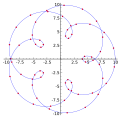Interpolation
Interpolation is a method of constructing new data points within the range of a discrete set of known data points. It is widely used in many fields including mathematics, physics, and computer graphics.
Overview[edit]
In the mathematical field, interpolation is a type of estimation, a method of constructing new data points within the range of a discrete set of known data points. The primary function of interpolation in mathematics is to estimate values that fall between two known values.
In computer graphics, interpolation is used to produce a smooth gradient or to resize digital images. In the realm of physics, it is used to predict values for an element based on the known values of surrounding elements.
Types of Interpolation[edit]
There are several types of interpolation methods, including:
- Linear Interpolation - This is the simplest method of interpolation. In this method, two points are connected by a straight line and the value of an intermediate point is estimated using this line.
- Polynomial Interpolation - This is a more general form of interpolation which involves fitting a polynomial that passes through given points.
- Spline Interpolation - This method involves fitting a special type of piecewise polynomial called a spline to the data points.
- Rational Interpolation - This is a type of interpolation where the interpolant is a rational function.
Applications[edit]
Interpolation has a wide range of applications in various fields. Some of the notable applications include:
- Image Processing - Interpolation is used in image processing to increase the size of an image or to correct distortions.
- Computer Graphics - In computer graphics, interpolation is used to create smooth transitions between points and lines.
- Numerical Analysis - Interpolation is used in numerical analysis to solve differential equations and to approximate functions.
- Geostatistics - In geostatistics, interpolation is used to predict unknown values for any geographic location, based on the values at surrounding locations.
See Also[edit]
References[edit]
<references />
|
|
|
-
Splined epitrochoid
-
Interpolation data
-
Piecewise constant interpolation
-
Linear interpolation example
-
Polynomial interpolation example
-
Spline interpolation example
-
Nearest 2D interpolation example
-
Bilinear interpolation example
-
Bicubic interpolation example
Ad. Transform your life with W8MD's Budget GLP-1 injections from $75


W8MD offers a medical weight loss program to lose weight in Philadelphia. Our physician-supervised medical weight loss provides:
- Weight loss injections in NYC (generic and brand names):
- Zepbound / Mounjaro, Wegovy / Ozempic, Saxenda
- Most insurances accepted or discounted self-pay rates. We will obtain insurance prior authorizations if needed.
- Generic GLP1 weight loss injections from $75 for the starting dose.
- Also offer prescription weight loss medications including Phentermine, Qsymia, Diethylpropion, Contrave etc.
NYC weight loss doctor appointmentsNYC weight loss doctor appointments
Start your NYC weight loss journey today at our NYC medical weight loss and Philadelphia medical weight loss clinics.
- Call 718-946-5500 to lose weight in NYC or for medical weight loss in Philadelphia 215-676-2334.
- Tags:NYC medical weight loss, Philadelphia lose weight Zepbound NYC, Budget GLP1 weight loss injections, Wegovy Philadelphia, Wegovy NYC, Philadelphia medical weight loss, Brookly weight loss and Wegovy NYC
|
WikiMD's Wellness Encyclopedia |
| Let Food Be Thy Medicine Medicine Thy Food - Hippocrates |
Medical Disclaimer: WikiMD is not a substitute for professional medical advice. The information on WikiMD is provided as an information resource only, may be incorrect, outdated or misleading, and is not to be used or relied on for any diagnostic or treatment purposes. Please consult your health care provider before making any healthcare decisions or for guidance about a specific medical condition. WikiMD expressly disclaims responsibility, and shall have no liability, for any damages, loss, injury, or liability whatsoever suffered as a result of your reliance on the information contained in this site. By visiting this site you agree to the foregoing terms and conditions, which may from time to time be changed or supplemented by WikiMD. If you do not agree to the foregoing terms and conditions, you should not enter or use this site. See full disclaimer.
Credits:Most images are courtesy of Wikimedia commons, and templates, categories Wikipedia, licensed under CC BY SA or similar.
Translate this page: - East Asian
中文,
日本,
한국어,
South Asian
हिन्दी,
தமிழ்,
తెలుగు,
Urdu,
ಕನ್ನಡ,
Southeast Asian
Indonesian,
Vietnamese,
Thai,
မြန်မာဘာသာ,
বাংলা
European
español,
Deutsch,
français,
Greek,
português do Brasil,
polski,
română,
русский,
Nederlands,
norsk,
svenska,
suomi,
Italian
Middle Eastern & African
عربى,
Turkish,
Persian,
Hebrew,
Afrikaans,
isiZulu,
Kiswahili,
Other
Bulgarian,
Hungarian,
Czech,
Swedish,
മലയാളം,
मराठी,
ਪੰਜਾਬੀ,
ગુજરાતી,
Portuguese,
Ukrainian











